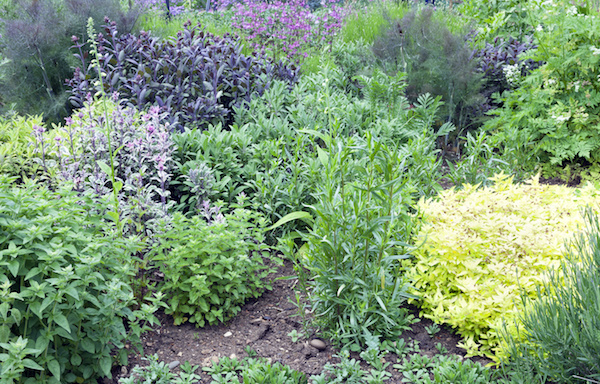
By Nancy McDonald
May is finally upon us and it’s time to start growing. When making your planting wishlist, consider culinary herbs – providers of great flavour and aroma.
Leaves, flowers, or seeds from culinary herbs add pleasure and nutrition to our diet. If you’re new to gardening, herbs are great starter plants. They’re easy to grow and relatively pest-free.They can grow in herb, vegetable or flower gardens,as well as containers. This makes them ideal for many spaces.
Herb tags and seed packets will provide information on whether the herb is an annual, biennial or perennial. Details also include preferred growing conditions, space needed, and the best time to sow relative to frost date.
I like to sow my annual herb seeds directly into containers or into my garden bed to limit damaging roots when transplanting. Basil, dill, and summer savoury plants are easy to grow from seed. Some herb seeds, such as parsley, have a tough outer shell, and will need to be scratched with sandpaper or soaked for 24 to 36 hours in hot water to soften. Other herb seeds may require a period of cold before they germinate.
Perennial herbs are often best started from cuttings or transplants. Some do not produce seed or come true from seed, while others can take up to three years from seed to reach harvest size. In addition to garden centres, local garden club sales often have herbs for you to purchase as members share their growing successes.
As with real estate, your success will be abundant if you choose the right location. Most herbs require six hours of sun per day and well-draining, moderately fertile soil. Herbs do not like wet feet and should not be over-fertilized. Too much nitrogen can reduce the production of essential oils, resulting in less flavour. The medium for container-grown herbs should be a soilless mix labelled as container or potting mix.
If combining herbs in a container, choose those which have similar growing conditions.Mediterranean herbs, such as sage, rosemary, thyme and oregano, work well together. You may want to try several varieties of the same herb together. Have fun choosing your containers. It is common in Europe to see basil grown in attractive recycled olive oil cans.
With so many herbs, where do you start? Take a look in your kitchen cupboard for favourite and most-used culinary herbs. Most of us have limited garden space on our urban lots and balconies, so be practical and grow what you’ll use.
I’ve often grown a particular herb based on a recipe. Lovage, a celery-flavoured herb, made its way into my garden after I read a potato scallop recipe in a favourite cookbook. Likewise, after I tasted sweet cicely tea biscuits, this aniseed-flavoured herb made its way into another garden bed. It is an attractive herb with fern-like leaves and delicate white spring flowers. It is one of the few herbs that can grow in shade. Sweet cicely leaves can be used to sweeten stewed fruit and yogourt, and to reduce sugar in baking.
As a transplanted Prince Edward Islander,the annual summer savoury is an essential herb in my garden. Traditionally in Atlantic Canadian homes, this herb is used in stuffings and meat pies. It is a common ingredient in Herbes de Provence. Other annual herbs I enjoy growing are basil, parsley, cilantro (also called coriander) and pineapple sage. Bay and rosemary are tender perennials that I grow in pots and bring indoors for winter use. Sage, oregano, thyme, winter savoury and mint overwinter nicely in my garden. I have brushed away the snow to harvest sage (aalvia officinalis) leaves in winter. For mints, I prefer spearmint (mentha spicata), as it is less likely to overpower a culinary dish. As all mints are aggressive spreaders, grow them in a container.
Harvest the herbs throughout the summer to use and enjoy. Late in the season you may wish to preserve some for future use. I dry savoury and oregano; freeze lovage and parsley (stalks and leaves); and make a paste in ice cube trays with tarragon,basil and sage.You may try making herb-flavoured vinegars, oils, honey, salts, butter and teas.The possibilities are endless and not that difficult, especially with many online resources and books to assist you. Imagine the delight of your friends and family if you accompany a salad with a pretty jar of tasty chive flower vinegar.
Fresh, homegrown herbs lead to lovely culinary experiences, but more importantly for you and your family, often provide an additional health benefit. They add variety, enhance flavour, reduce the use of unhealthy additives, such as salt, sugar and fat, and add virtually no additional calories. According to the University of Michigan Health System, one teaspoon (five millilitres) of oregano added to my pasta sauce contains as much antioxidants as three cups (700 millilitres) of broccoli! While the benefits are great, keep in mind that culinary herbs are always recommended for use in small amounts.
So start growing culinary herbs for great taste, flavour, and good health. n
Nancy McDonald is retired from nursing and joined Master Gardeners of Ottawa-Carleton to volunteer and learn in retirement.
Resource
Master Gardeners of Ottawa-Carleton mgottawa.ca.






